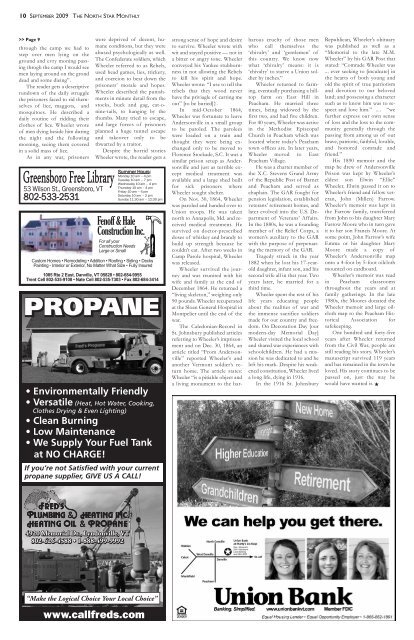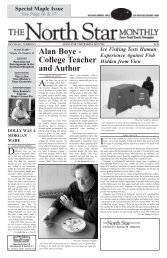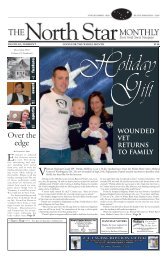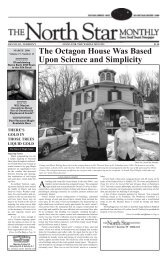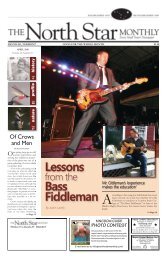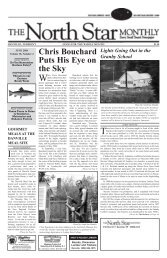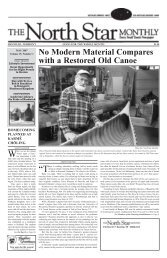Eyes ofHistory - The North Star Monthly
Eyes ofHistory - The North Star Monthly
Eyes ofHistory - The North Star Monthly
You also want an ePaper? Increase the reach of your titles
YUMPU automatically turns print PDFs into web optimized ePapers that Google loves.
10 SEPTEMBER 2009 THE NORTH STAR MONTHLY<br />
>> Page 9<br />
through the camp we had to<br />
step over men lying on the<br />
ground and evry moning passing<br />
throgh the camp I would see<br />
men laying around on the grond<br />
dead and some dieing”.<br />
<strong>The</strong> reader gets a descriptive<br />
rundown of the daily struggle<br />
the prisoners faced to rid themselves<br />
of lice, maggots, and<br />
mosquitoes. He described a<br />
daily routine of ridding their<br />
clothes of lice. Wheeler wrote<br />
of men dying beside him during<br />
the night and the following<br />
morning, seeing them covered<br />
in a solid mass of lice.<br />
As in any war, prisoners<br />
53 Wilson St., Greensboro, VT<br />
802-533-2531<br />
were deprived of decent, humane<br />
conditions, but they were<br />
abused psychologically as well.<br />
<strong>The</strong> Confederate soldiers, which<br />
Wheeler referred to as Rebels,<br />
used head games, lies, trickery,<br />
and coercion to beat down the<br />
prisoners’ morale and hopes.<br />
Wheeler described the punishments<br />
in minute detail from the<br />
stocks, buck and gag, cat-onine-tails,<br />
to hanging by the<br />
thumbs. Many tried to escape,<br />
and large forces of prisoners<br />
planned a huge tunnel escape<br />
and takeover only to be<br />
thwarted by a traitor.<br />
Despite the horrid stories<br />
Wheeler wrote, the reader gets a<br />
Summer Hours:<br />
Monday 10 am – 4 pm<br />
Tuesday 10 am – 7 pm<br />
Wednesday 10 am – 4 pm<br />
Thursday 10 am – 4 pm<br />
Friday 10 am – 4 pm<br />
Saturday 10 am – 2 pm<br />
Sunday 11:30 am – 12:30 pm<br />
Fenoff & Hale<br />
Construction Inc.<br />
For all your<br />
Construction Needs<br />
Large or Small<br />
Custom Homes • Remodeling • Addition • Roofing • Siding • Decks<br />
Painting - Interior or Exterior, No Matter What Size • Fully Insured<br />
1085 Rte 2 East, Danville, VT 05828 • 802-684-9955<br />
Trent Cell 802-535-9108 • Nate Cell 802-535-7303 • Fax 802-684-3414<br />
strong sense of hope and desire<br />
to survive. Wheeler wrote with<br />
wit and stayed positive — not in<br />
a bitter or angry tone. Wheeler<br />
conveyed his Yankee stubbornness<br />
in not allowing the Rebels<br />
to kill his spirit and hope.<br />
Wheeler wrote: “I use to tell the<br />
rebels that they wood never<br />
have the priviagle of carring me<br />
out” [to be buried]}.<br />
In mid-October 1864,<br />
Wheeler was fortunate to leave<br />
Andersonville in a small group<br />
to be paroled. <strong>The</strong> parolees<br />
were loaded on a train and<br />
thought they were being exchanged<br />
only to be moved to<br />
Florence Stockade, S.C. It was a<br />
similar prison setup as Andersonville<br />
and just as terrible except<br />
medical treatment was<br />
available and a large shed built<br />
for sick prisoners where<br />
Wheeler sought shelter.<br />
On Nov. 30, 1864, Wheeler<br />
was paroled and handed over to<br />
Union troops. He was taken<br />
north to Annapolis, Md. and received<br />
medical treatment. He<br />
survived on doctor-prescribed<br />
doses of whiskey and brandy to<br />
build up strength because he<br />
couldn’t eat. After two weeks in<br />
Camp Parole hospital, Wheeler<br />
was released.<br />
Wheeler survived the journey<br />
and was reunited with his<br />
wife and family at the end of<br />
December 1864. He returned a<br />
“living skeleton,” weighing only<br />
90 pounds. Wheeler recuperated<br />
at the Sloan General Hospital in<br />
Montpelier until the end of the<br />
war.<br />
<strong>The</strong> Caledonian-Record in<br />
St. Johnsbury published articles<br />
referring to Wheeler’s imprisonment<br />
and on Dec. 30, 1864, an<br />
article titled “From Andersonville”<br />
reported Wheeler’s and<br />
another Vermont soldier’s return<br />
home. <strong>The</strong> article states:<br />
Wheeler “is a pitiable object and<br />
a living monument to the bar-<br />
barous cruelty of those men<br />
who call themselves the<br />
‘chivalry’ and ‘gentlemen’ of<br />
this country. We know now<br />
what ‘chivalry’ means: it is<br />
‘chivalry’ to starve a Union soldier<br />
by inches.”<br />
Wheeler returned to farming,<br />
eventually purchasing a hilltop<br />
farm on East Hill in<br />
Peacham. He married three<br />
times, being widowed by the<br />
first two, and had five children.<br />
For 40 years, Wheeler was active<br />
in the Methodist Episcopal<br />
Church in Peacham which was<br />
located where today’s Peacham<br />
town offices are. In later years,<br />
Wheeler moved to East<br />
Peacham Village.<br />
He was a charter member of<br />
the X.C. Stevens Grand Army<br />
of the Republic Post of Barnet<br />
and Peacham and served as<br />
chaplain. <strong>The</strong> GAR fought for<br />
pension legislation, established<br />
veterans’ retirement homes, and<br />
later evolved into the U.S. Department<br />
of Veterans’ Affairs.<br />
In the 1880s, he was a founding<br />
member of the Relief Corps, a<br />
women’s auxiliary to the GAR<br />
with the purpose of perpetuating<br />
the memory of the GAR.<br />
Tragedy struck in the year<br />
1882 when he lost his 17-yearold<br />
daughter, infant son, and his<br />
second wife all in that year. Two<br />
years later, he married for a<br />
third time.<br />
Wheeler spent the rest of his<br />
life years educating people<br />
about the realities of war and<br />
the immense sacrifice soldiers<br />
made for our country and freedom.<br />
On Decoration Day [our<br />
modern-day Memorial Day]<br />
Wheeler visited the local school<br />
and shared war experiences with<br />
schoolchildren. He had a mission<br />
he was dedicated to and he<br />
left his mark. Despite his weakened<br />
constitution, Wheeler lived<br />
a long life, dying in 1916.<br />
In the 1916 St. Johnsbury<br />
Republican, Wheeler’s obituary<br />
was published as well as a<br />
“Memorial to the late M.M.<br />
Wheeler” by his GAR Post that<br />
stated: “Comrade Wheeler was<br />
... ever seeking to [inculcate] in<br />
the hearts of both young and<br />
old the spirit of true patriotism<br />
and devotion to our beloved<br />
land; and possessing a character<br />
such as to know him was to respect<br />
and love him.” .... “we<br />
further express our own sense<br />
of loss and the loss to the community<br />
generally through the<br />
passing from among us of our<br />
brave, patriotic, faithful, lovable,<br />
and honored comrade and<br />
friend.”<br />
His 1890 memoir and the<br />
map he drew of Andersonville<br />
Prison was kept by Wheeler’s<br />
eldest son Elwin “Ellie”<br />
Wheeler. Elwin passed it on to<br />
Wheeler’s friend and fellow veteran,<br />
John (Millen) Farrow.<br />
Wheeler’s memoir was kept in<br />
the Farrow family, transferred<br />
from John to his daughter Mary<br />
Farrow Moore who in turn gave<br />
it to her son Francis Moore. At<br />
some point, John Farrow’s wife<br />
Emma or his daughter Mary<br />
Moore made a copy of<br />
Wheeler’s Andersonville map<br />
onto a 4-foot by 5-foot oilcloth<br />
mounted on cardboard.<br />
Wheeler’s memoir was read<br />
in Peacham classrooms<br />
throughout the years and at<br />
family gatherings. In the late<br />
1980s, the Moores donated the<br />
Wheeler memoir and large oilcloth<br />
map to the Peacham Historical<br />
Association for<br />
safekeeping.<br />
One hundred and forty-five<br />
years after Wheeler returned<br />
from the Civil War, people are<br />
still reading his story. Wheeler’s<br />
manuscript survived 119 years<br />
and has remained in the town he<br />
loved. His story continues to be<br />
passed on, just the way he<br />
would have wanted it. �


